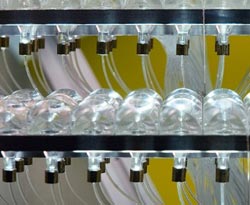Bringing in the Sunshine with Sollectors on the Roof

The latest issue of the research magazine “Pictures of the Future” features a report on how this is to be achieved. Sunlight is collected by “sollectors” on the roof and fed into waveguides, which run throughout the building.
The waveguides emerge from the room ceilings, where they supply a special light that provides additional artificial lighting from light-emitting diodes (LEDs) if needed. The Siemens subsidiary Osram and its partners are building the prototype of such an LED light.
This direct utilization of sunlight is highly efficient. Between 50 and 70 percent of the captured light supplements the room lighting. In contrast, if you use the light to produce solar energy which is then used to power a conventional lamp, the light energy generated is only a few percent of the amount of energy originally collected.
The sollector is a square plate measuring just over half a meter on each side. A total of 900 lenses collect the sunlight and feed it into fiber optic cables. Ultraviolet radiation, which is damaging to the skin, and the infrared component, which heats up rooms, are filtered out. In strong sunlight, a sollector can supply a room with light equivalent to that produced by a dozen 60-watt light bulbs. The device was developed at the Georg Simon Ohm University of Applied Sciences in Nuremberg, Germany, and a startup founded by the university is already marketing the technology.
The LED version is now being produced in collaboration with Osram. The light from the fiber optic cables makes a flat lamp light up. The light from white LEDs is also directed onto the flat surface. Special sensors, which are adjusted in line with the light sensitivity of humans, register the point at which additional artificial light is needed. The spectral composition of natural light changes during the course of a day, so the color of the white LED light is varied depending on the time of day. Red light is added in the morning and evening, and the amount of blue is increased during the daytime.
Sollectors utilize only direct sunlight, not the diffuse radiation from an overcast sky, so it pays to use them in sunny regions in particular. Building inhabitants in such locations block the sun from entering the interior to keep rooms from becoming too warm and turn on the lights instead. In the future they may be able to capture sunlight and guide the brightness — without any warming infrared radiation — to where it is needed.
Media Contact
More Information:
http://www.siemens.com/researchnewsAll latest news from the category: Power and Electrical Engineering
This topic covers issues related to energy generation, conversion, transportation and consumption and how the industry is addressing the challenge of energy efficiency in general.
innovations-report provides in-depth and informative reports and articles on subjects ranging from wind energy, fuel cell technology, solar energy, geothermal energy, petroleum, gas, nuclear engineering, alternative energy and energy efficiency to fusion, hydrogen and superconductor technologies.
Newest articles

Properties of new materials for microchips
… can now be measured well. Reseachers of Delft University of Technology demonstrated measuring performance properties of ultrathin silicon membranes. Making ever smaller and more powerful chips requires new ultrathin…

Floating solar’s potential
… to support sustainable development by addressing climate, water, and energy goals holistically. A new study published this week in Nature Energy raises the potential for floating solar photovoltaics (FPV)…

Skyrmions move at record speeds
… a step towards the computing of the future. An international research team led by scientists from the CNRS1 has discovered that the magnetic nanobubbles2 known as skyrmions can be…





















